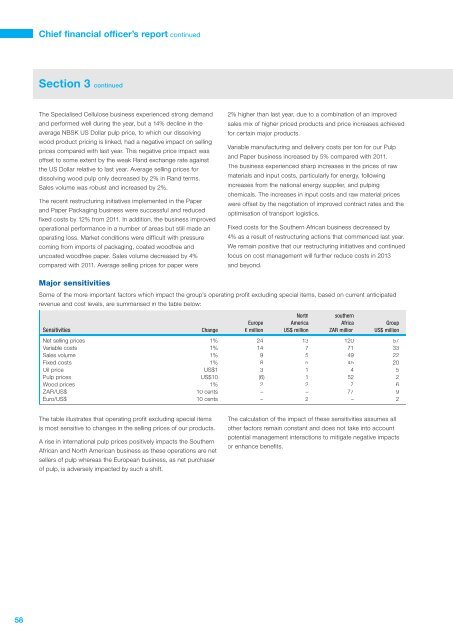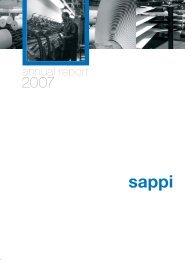2012 Integrated report - Sappi
2012 Integrated report - Sappi
2012 Integrated report - Sappi
You also want an ePaper? Increase the reach of your titles
YUMPU automatically turns print PDFs into web optimized ePapers that Google loves.
Chief financial officer’s <strong>report</strong> continued<br />
Section 3 continued<br />
The Specialised Cellulose business experienced strong demand<br />
and performed well during the year, but a 14% decline in the<br />
average NBSK US Dollar pulp price, to which our dissolving<br />
wood product pricing is linked, had a negative impact on selling<br />
prices compared with last year. This negative price impact was<br />
offset to some extent by the weak Rand exchange rate against<br />
the US Dollar relative to last year. Average selling prices for<br />
dissolving wood pulp only decreased by 2% in Rand terms.<br />
Sales volume was robust and increased by 2%.<br />
The recent restructuring initiatives implemented in the Paper<br />
and Paper Packaging business were successful and reduced<br />
fixed costs by 12% from 2011. In addition, the business improved<br />
operational performance in a number of areas but still made an<br />
operating loss. Market conditions were difficult with pressure<br />
coming from imports of packaging, coated woodfree and<br />
uncoated woodfree paper. Sales volume decreased by 4%<br />
compared with 2011. Average selling prices for paper were<br />
2% higher than last year, due to a combination of an improved<br />
sales mix of higher priced products and price increases achieved<br />
for certain major products.<br />
Variable manufacturing and delivery costs per ton for our Pulp<br />
and Paper business increased by 5% compared with 2011.<br />
The business experienced sharp increases in the prices of raw<br />
materials and input costs, particularly for energy, following<br />
increases from the national energy supplier, and pulping<br />
chemicals. The increases in input costs and raw material prices<br />
were offset by the negotiation of improved contract rates and the<br />
optimisation of transport logistics.<br />
Fixed costs for the Southern African business decreased by<br />
4% as a result of restructuring actions that commenced last year.<br />
We remain positive that our restructuring initiatives and continued<br />
focus on cost management will further reduce costs in 2013<br />
and beyond.<br />
Major sensitivities<br />
Some of the more important factors which impact the group’s operating profit excluding special items, based on current anticipated<br />
revenue and cost levels, are summarised in the table below:<br />
Sensitivities<br />
Change<br />
Europe<br />
€ million<br />
North<br />
America<br />
US$ million<br />
Southern<br />
Africa<br />
ZAR million<br />
Group<br />
US$ million<br />
Net selling prices 1% 24 13 120 57<br />
Variable costs 1% 14 7 71 33<br />
Sales volume 1% 9 5 49 22<br />
Fixed costs 1% 8 5 45 20<br />
Oil price US$1 3 1 4 5<br />
Pulp prices US$10 (6) 1 62 2<br />
Wood prices 1% 2 2 7 6<br />
ZAR/US$ 10 cents – – 77 9<br />
Euro/US$ 10 cents – 2 – 2<br />
The table illustrates that operating profit excluding special items<br />
is most sensitive to changes in the selling prices of our products.<br />
A rise in international pulp prices positively impacts the Southern<br />
African and North American business as these operations are net<br />
sellers of pulp whereas the European business, as net purchaser<br />
of pulp, is adversely impacted by such a shift.<br />
The calculation of the impact of these sensitivities assumes all<br />
other factors remain constant and does not take into account<br />
potential management interactions to mitigate negative impacts<br />
or enhance benefits.<br />
58
















